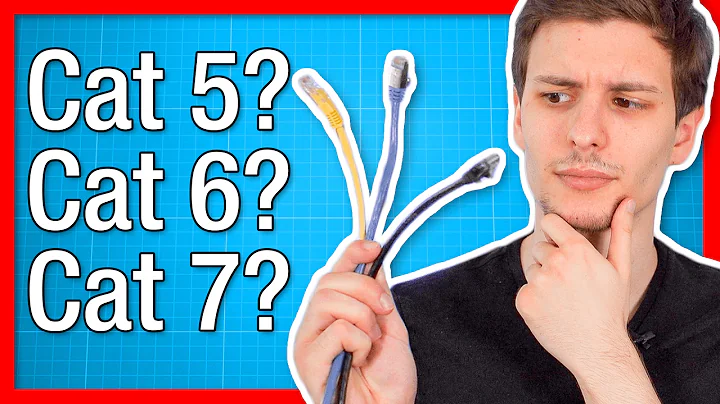New office cabling: should we use CAT7 or CAT6a?
Solution 1
These connections are rated to carry these speeds at the distance specified:
| 10/100Mb | 1Gb | 10Gb | 40Gb† | 100Gb‡
Category | 100m | 37m | 100m | 55m | 100m | 50m | 100m | 15m | 100m
---------+----------+-----+------+-----+------+-----+------+-----+-----
5 | x | x | | | | | | |
5e | X | X | X | X | | | | |
6 | x | x | x | x | | | | |
6a | X | X | X | X | X | | | |
F/7† | x | x | x | x | x | x‡ | | x‡ |
Fa/7a† | X | X | X | X | X | X† | X‡ | X† | X‡
Legend:
- Unless otherwise noted: The specification has been formalized and accepted. Keep in mind that the end-to-end cabling needs to be rated according to the category or you can expect reduced distance (since it's a digital system it normally either works or doesn't, though you can limit the speed of the connection to possibly allow functionality).
- † These are draft specifications. No guarantees, but it's reasonably safe to assume the final specification will be substantially similar.
- ‡ There is some reasonable speculation that with advances in circuity these connections will be possible. However, with current technology they do not work.
Notes:
- Cat7 is officially known as CatF, and Cat7a as CatFa, in the current draft. This may change to be consistent with the previous numbering scheme, or they may keep the letter designation.
- 40GbE and faster does not use the RJ45 connection, it uses GG45. There is a connector known as ARJ45 which has pins for both, and is intended to be an intermediate step.
- I've seen cables advertized as Cat7/Cat7a without the GG45 or ARJ45 ends, these may be just Shielded lower grade cables since there is no "7" yet. There is no official specification to which manufacturers would have to adhere.
More information on the various Ethernet standards is available in my answer to What is the clock frequency inside 10Gb and 100Gb Ethernet cards?
Solution 2
I'll take a contrarian view here.
There is nearly no value in going from cat5e to cat6a in almost all office environments.
10gb copper is nasty, expensive, and flakey. It uses far more space than 5e, is heavier, and is harder to install. You have to fully test the entire cable plant including your patch cables if you want it to work. And by test I mean "use a cable tester" not "plug a computer in and watch a link light come up". And it gets you nothing unless you're going to actually run it at 10gb -- because 1gb works just fine on the cheaper stuff and doesn't work better on the expensive stuff.
If you're going to be going 10gb/sec because you have legit reasons (you do geology / video / VM image work / etc) -- skip the copper. Go straight to fiber. But even that only gets you 10gb because the 40gb standard requires 4 pairs per link.
Another option is to only wire up those specific ports that actually need the 10gb over copper and just use 5e for everything else. Otherwise you'll be spending 10x as much money as you need to for those VOIP phone ports.
If this is a greenfield deployment just have them run conduits and leave cable pulls in place -- that way you can pull what you need right now and replace it with what you need later, rather than spending a huge amount of money installing FDDI and ATM everywhere.
No great choices...
Solution 3
Cat7 has different plugs, make sure you get ones with GG45 connectors, as they are backwards compatible to RJ45 (8P8C).
Solution 4
Cable category garanties you that your cable fits some requirements in terms of bandwidth and capacity, it doesn't tell you anything about the transmission medium (It could be coaxial, twisted-pair of copper or optical fiber.
Category 6a operates at a frequency of 550 MHz and is backward compatible with the existing standards. This technology is suitable for industry sectors utilizing high performance computing platforms to support very high bandwidth intensive applications. 10G/Cat 6a applications would initially be deployed in server farms, storage area networks, and data centers. It supports 10G
Cat 7 is likely to have a natural death as it is unadaptable, have issues in installation and cables ought to be re-pulled
I would definitely select CAT6a instead of CAT7.
Related videos on Youtube
I don't know.
Updated on September 18, 2022Comments
-
I don't know. almost 2 years
We are going to do the cabling in our new office building and we are thinking to lay down 10Gbit cables since we use HP switches that come with 10Gbit ethernet ports. We will also lay down few fiber optic cables, just in case :).
What we are wondering now is should we use CAT6e or CAT7 cables for 10Gbit? Are they backward compatible, i.e. can we use them with 1Gbit swiches/PCs/Servers?
Thanks.
-
 Philip about 11 yearsPutting the money saved by using Cat5e in a savings account would likely pay for more than just installing Cat7 cable by the time they actually need those speeds. Planning for the future isn't just buying the best available right now, but balancing the costs and benefits, especially with such long times involved the time value of money must be considered as well.
Philip about 11 yearsPutting the money saved by using Cat5e in a savings account would likely pay for more than just installing Cat7 cable by the time they actually need those speeds. Planning for the future isn't just buying the best available right now, but balancing the costs and benefits, especially with such long times involved the time value of money must be considered as well. -
 ewwhite about 11 yearsIn short, use Cat6.
ewwhite about 11 yearsIn short, use Cat6. -
 Philip about 11 yearsDespite what the Wikipedia article says I'm pretty sure a cable wired for the new standard will not work in an older socket. And older cabling only works in an "active" GG45 socket.
Philip about 11 yearsDespite what the Wikipedia article says I'm pretty sure a cable wired for the new standard will not work in an older socket. And older cabling only works in an "active" GG45 socket. -
 Philip about 11 yearsI think you mean Cat6a, the 10Gb stuff. I would generally agree with that for new installations, yep.
Philip about 11 yearsI think you mean Cat6a, the 10Gb stuff. I would generally agree with that for new installations, yep. -
 NickW about 11 years@Chris S Not just wikipedia, cabletool.net/Kerpen/Data_System_Cable/82.PDF but I haven't had much of an opportunity to test said compatibility. Maybe I should change the text to read GG45 jacks.
NickW about 11 years@Chris S Not just wikipedia, cabletool.net/Kerpen/Data_System_Cable/82.PDF but I haven't had much of an opportunity to test said compatibility. Maybe I should change the text to read GG45 jacks. -
 Philip about 11 yearsI don't own any GG45 equipment yet. Someone just showed my a Cat7 cable once with the GG45 connector on it, it only had pins 1/2 and 7/8 on the RJ45 side. Pins 3/6 are necessary for 100Mb use in an RJ45 socket; all the pins are needed for 1GbE. But I agree the marketing says 100% backward compatible all over the place.
Philip about 11 yearsI don't own any GG45 equipment yet. Someone just showed my a Cat7 cable once with the GG45 connector on it, it only had pins 1/2 and 7/8 on the RJ45 side. Pins 3/6 are necessary for 100Mb use in an RJ45 socket; all the pins are needed for 1GbE. But I agree the marketing says 100% backward compatible all over the place. -
 NickW about 11 yearsWouldn't be the first time marketing had no bearing in reality :)
NickW about 11 yearsWouldn't be the first time marketing had no bearing in reality :) -
chris about 11 yearsFWIW -- I've run 1gb on cat5 and I've run 10gb on cat5e that I made myself. That is actually one of the things that makes me really wary of these standards and the actual installs. The standards make it so a catX install will work in all situations -- reality is worse -- it will work when you "test" it with a couple nodes then act weird when you add the 80th node to the network.
-
chris about 11 yearsI think you misunderstand -- the "Standard" only works if you've tested the whole cable install. Port to port. If your vendor doesn't do a full test, or if you substitute a non-cat6a cable as a patch cable, or if the structured cabling gets roughhoused because someone has to replace a switch -- you'll easily wind up with a non-cat6a install that still works at 10gb, but not always, such as maybe when you've plugged your 30th 10gb node in, long after the incident that actually degraded the cable.
-
 Philip about 11 yearsI don't misunderstand; if you use non-standard components then you don't have a standards compliant installation. You have explained this quite well actually. Whether it's the 30th node or the 80th makes no real different, non-standard != standard.
Philip about 11 yearsI don't misunderstand; if you use non-standard components then you don't have a standards compliant installation. You have explained this quite well actually. Whether it's the 30th node or the 80th makes no real different, non-standard != standard. -
chris about 11 yearsThe install isn't only the components -- it is trivial to have a cat5e install made up of entirely components rated as cat6a. The only way to tell the difference is with one of these: datacomtools.com/catalog/cat-6-tester.htm -- and not the $1300 one, you have to use the $10,000 one. And when there's fishy behavior on your "cat6a" network 3 years after it is installed, you think any typical shop will have one of these in their cable test kit?
-
Mike over 8 yearsAre you sure cat5e can do 10Gb speeds? Everywhere I read it says 1 Gb (e.g. directron.com/cableguide.html and diffen.com/difference/Cat5e_vs_Cat6 to name a couple).
-
 Philip over 8 years@Mike Cat5e should do 10Gb at very short distances, just as the original Cat6 should, If you want cables guaranteed to work at distances up to 100m, Cat6A is guaranteed to work. Most people are only concerned with what can be guaranteed to work (with the normal "nothing's screwy" assumptions).
Philip over 8 years@Mike Cat5e should do 10Gb at very short distances, just as the original Cat6 should, If you want cables guaranteed to work at distances up to 100m, Cat6A is guaranteed to work. Most people are only concerned with what can be guaranteed to work (with the normal "nothing's screwy" assumptions).




